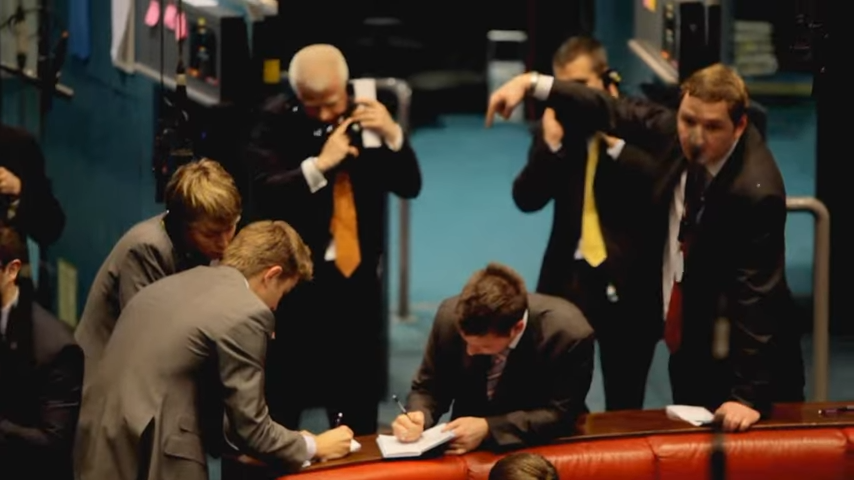
The future of ring trading on the London Metal Exchange looks assured for now after almost all the firms involved told Reuters they remained committed to open-outcry trading at one of the last venues to still support it.
But with critical mass dropping towards the level at which LME management has said it would suspend the process after Societe Generale said last week it would no longer take part, its longer term outlook is less sure.
The ring has its roots in the early 19th century when the Royal Exchange, the world’s first commodities market, became so crowded that metal merchants gathered at the Jerusalem coffee house on Cornhill in the City to conduct business.
In the 1980s, about 30 firms dealt in the LME ring, which features a circle of padded red leather seats for traders who use arcane hand signals during five-minute bursts of intense trading in copper, aluminum and other metals.
Now, just seven participants remain, and the LME has said the floor will close if the number of ring members falls below six, or if their trading in the second ring falls to less than 75% of last year’s level.
The LME, owned by Hong Kong Exchanges and Clearing Ltd, said on Friday that trading volumes remain above the 75% threshold, but did not say by how much. It declined to comment further.
Several sources said high costs for ring-dealing firms and a global trend towards electronic trade threaten to undermine the minimum number of participants required to keep the age-old trading method afloat.
The loss of the ring, which involves four sessions of trading a day, would be a blow for miners and industrial firms that value floor trading.
They regard open-outcry dealing, used to crystalize official prices for physical deals using a complex structure of multiple forward dates, as absent of speculative influences.
For years, there has been tension between traditional physical users and the financial community that includes hedge funds, speculators and Commodity Trade Advisor investment funds and funds driven by algorithmic programs.
Many long-standing users see a risk too that an excess of computer-driven speculative flows can distort prices that are key to deals in physical metal.
“It’s that second ring close, the official price, that’s void of algos, void of CTAs, void of specs, that still has an appeal,” said Marc Bailey, CEO of ring-trader Sucden Financial.
An outcry from physical LME users saved the ring three years ago when the 147-year-old LME proposed to close the trading floor and join the bulk of other financial exchanges that have moved to pure electronic trading.
The exchange argued that a temporary switch to full digital trading during Covid-19 proved that the ring was not essential.
But the LME eventually compromised and now operates on a hybrid basis, using open-outcry trading for official prices used by physical users as benchmarks for their deals and an electronic system for closing prices.
Longstanding questions about the viability of the ring resurfaced on Aug. 23 when Societe Generale said it would drop the top-tier membership that allows floor trading.
A Reuters survey showed there is still a commitment to the ring for now by the bulk of existing ring members, backed by miners and companies that use physical metal.
“There are enough people that still want an independent price for physical trading,” said Sucden’s Bailey.
Marex Group also said it would continue ring trading, while StoneX Financial said it had no current plans to change its approach to the ring.
Sources with direct knowledge said Amalgamated Metal Trading, CCBI Global Markets and GF Financial also planned to continue on the LME floor, while Sigma Broking declined to comment.
Ring members must bear the extra cost of having traders both in the office and on the LME floor, which can cost $1 million a year, one industry source estimated.
“It’s expensive to maintain, but we’re still making money from the ring,” said an executive of a ring dealer who declined to be named.
SocGen was a relatively small player in the ring, and one LME executive estimated the company accounted for only 6% of open-outcry trading. An executive at an LME ring dealer said they expected its ring business to be redistributed to one or more of the remaining brokers.
Some LME members argue that electronic trading worked during Covid-19 and a full shift is inevitable.
“The writing is in the wall,” said an industry source. “The ring is actually irrelevant, as those prices were compiled electronically during Covid and no one noticed any difference.”
But the ring still has support. One executive at a European company that buys LME metals to make its products said the exchange should create a more viable ring by coming up with more cost-efficient solution.
“Without the ring, the LME is just another raw materials exchange,” he said.
(By Eric Onstad; Editing by Veronica Brown and Jan Harvey)
Comments